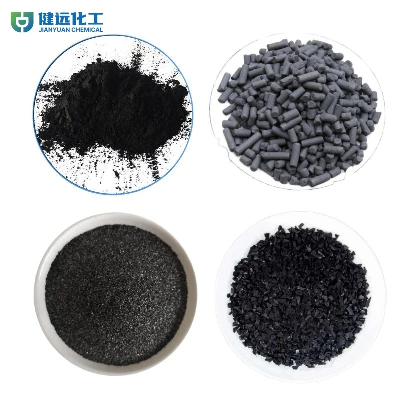Activated carbon is a specially treated carbon that heats
organic raw materials (fruit shells, coal, wood, etc.) under the
condition of isolation from air to reduce non-carbon components
(this process is called carbonization), and then reacts with the
gas to erode the surface and produce a structure with developed
micropores (this process is called activation). Since the
activation process is a microscopic process, that is, the surface
erosion of a large number of molecular carbides is point-like
erosion, so the surface of activated carbon has numerous small
pores.Product NameActivated CarbonTypeSolvent recovery coal
columnar activated carbon;Wood powdered activated carbon;Coconut
shell activated carbon;Coal columnar granular carbon;Household odor
removal activated carbon;Coal-based granular activated
carbon;Activated carbon for water purification;Activated carbon
from fruit shell;Coal column carbon for desulfurizationProduct
GradeIndustry Grade; Food Grade; Pharmaceutical
GradeClassificationCoal-based, Wooden, shell, Synthetic material,
etcShapeColumnar, granule, powder, flake(1) Treatment of oily
sewageOil-water separation by adsorption method is the use of
lipophilic materials to adsorb dissolved oil and other dissolved
organic matter in wastewater.(2) Treatment of dye wastewaterThe
composition of dye wastewater is complicated, the water quality
changes greatly, the color is deep, the concentration is large, and
the treatment is difficult. The main treatment methods are
oxidation, adsorption, membrane separation, flocculation,
biodegradation and so on. Each of these methods has advantages and
disadvantages, among which activated carbon can effectively remove
the chroma and COD of wastewater.(3) Treatment of wastewater
containing HgActivated carbon has the ability to adsorb Hg and
Hg-containing compounds, but the adsorption capacity is limited,
and it is only suitable for treating wastewater with low Hg
content.(4) Treatment of chromium-containing wastewaterThe
treatment of wastewater containing chromium by activated carbon is
the result of physical adsorption, chemical adsorption and chemical
reduction of hexavalent chromium in solution by activated carbon.
The treatment of chromium-containing wastewater by activated carbon
has stable adsorption performance, high treatment efficiency, low
operating cost, and certain social and economic benefits.
Therefore, the treatment of chromium-containing wastewater with
activated carbon has been widely used.(5) Catalytic and supported
catalystsActivated carbon is widely used as catalyst because of the
existence of crystallization defects, and because of its large
specific surface area and porous structure, activated carbon is
also widely used as catalyst carrier.(6) Clinical medicineBecause
of its good adsorption properties, activated carbon can be used for
acute clinical gastrointestinal detoxification first aid, it has
the advantages of not being absorbed by the gastrointestinal tract,
no irritation, can be taken directly, simple and convenient.(7) For
supercapacitor electrodesSupercapacitors are mainly composed of
electrode active material, electrolyte, fluid collector and
diaphragm, among which electrode material directly determines the
performance of the capacitor. Activated carbon has the advantages
of large specific surface area, well-developed pores and easy
preparation, and has become the earliest carbon electrode material
used in supercapacitors.(8) For hydrogen storageCommon hydrogen
storage methods include high-pressure gaseous hydrogen storage,
liquefied hydrogen storage, metal alloy hydrogen storage, organic
liquid hydride hydrogen storage, carbon material hydrogen storage,
etc. Carbon materials mainly include super activated carbon, carbon
nanofibers and carbon nanotubes. The super activated carbon has
attracted wide attention because of its rich raw materials, large
specific surface area, surface chemical properties modification,
large hydrogen storage, fast desorption speed, long cycle life and
easy industrialization.9.For flue gas treatmentIn the process of
desulfurization and denitrification, activated carbon material
attracts attention because of its advantages of good treatment
effect, low investment and operation cost, resource utilization,
and easy recycling, but a single activated carbon desulfurization
is slow and low efficiency. In the process of improving the
desulfurization performance of activated carbon, the modified
activated carbon has attracted attention, it can overcome some
shortcomings and limitations of ordinary activated carbon, and is
considered to be one of the most promising desulfurization
agents.
Powder Products
Liquid Products
Related products about China Supply Various Specs Active Carbon Powder Granular Activated Carbon
-
 Waste Tyre Plastic Recycling Machinery Machine Tire Crusher Production Line Rubber Crumb Grinding Machine Equipment Tire Shredder
Waste Tyre Plastic Recycling Machinery Machine Tire Crusher Production Line Rubber Crumb Grinding Machine Equipment Tire Shredder
-
 Stretch Plastic Blowing Pet Bottle Making Blow Molding Machine Bottles Stretch Automatic Pet Bottle Blowing Machine
Stretch Plastic Blowing Pet Bottle Making Blow Molding Machine Bottles Stretch Automatic Pet Bottle Blowing Machine
-
 Waste Plastic Pet Bottle, Water Bottle Flake, PP/HDPE/LDPE PE Film Jumbo Woven Bags Plastic Crusher Machine, Plastic Crushing Washing Recycling Machine
Waste Plastic Pet Bottle, Water Bottle Flake, PP/HDPE/LDPE PE Film Jumbo Woven Bags Plastic Crusher Machine, Plastic Crushing Washing Recycling Machine
-
 Type 2 Wall-Mounted Electric Car Charging Station 7kw /11 Kwelectric Vehicle Charging Station Home Wallbox AC EV Charger Single Phase or 3three Phase
Type 2 Wall-Mounted Electric Car Charging Station 7kw /11 Kwelectric Vehicle Charging Station Home Wallbox AC EV Charger Single Phase or 3three Phase
-
 G-View G12W Wholesale Auto Car LED Headlight Bulb High Power H13 H11 9005 H7 H4 Car LED Headlights LED Car Lights
G-View G12W Wholesale Auto Car LED Headlight Bulb High Power H13 H11 9005 H7 H4 Car LED Headlights LED Car Lights
-
 New Design Porcelain Round Plates Dinner Set for Wedding and Banquet
New Design Porcelain Round Plates Dinner Set for Wedding and Banquet
-
 China 2023 New Design Super Soft 100% Polyester Microfiber Knitted Oversized Decoration Hoodie Blanket
China 2023 New Design Super Soft 100% Polyester Microfiber Knitted Oversized Decoration Hoodie Blanket
-
 Handmade Art Creative Materials Thickened White Paper Cup DIY Disposable Handmade Colored Paper Cup
Handmade Art Creative Materials Thickened White Paper Cup DIY Disposable Handmade Colored Paper Cup



